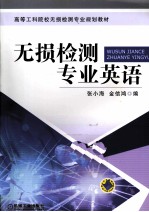图书介绍
无损检测专业英语PDF|Epub|txt|kindle电子书版本网盘下载

- 张小海,金信鸿编 著
- 出版社: 北京:机械工业出版社
- ISBN:9787111347965
- 出版时间:2012
- 标注页数:239页
- 文件大小:26MB
- 文件页数:253页
- 主题词:无损检验-英语-高等学校-教材
PDF下载
下载说明
无损检测专业英语PDF格式电子书版下载
下载的文件为RAR压缩包。需要使用解压软件进行解压得到PDF格式图书。建议使用BT下载工具Free Download Manager进行下载,简称FDM(免费,没有广告,支持多平台)。本站资源全部打包为BT种子。所以需要使用专业的BT下载软件进行下载。如BitComet qBittorrent uTorrent等BT下载工具。迅雷目前由于本站不是热门资源。不推荐使用!后期资源热门了。安装了迅雷也可以迅雷进行下载!
(文件页数 要大于 标注页数,上中下等多册电子书除外)
注意:本站所有压缩包均有解压码: 点击下载压缩包解压工具
图书目录
Chapter 1 Quality Control and NDT1
1.1 NDT in Industry1
1.2 NDT in Everyday Life3
1.3 History of NDT4
1.4 Understand the NDT Choices6
1.5 Reliability of NDT7
1.6 International Organizations of Quality Control and NDT8
Words and Phrases9
Notes10
Exercises11
Appendix Ⅰ 质量控制常用术语的中英双解12
Appendix Ⅱ 国外主要无损检测学术机构、组织介绍13
Chapter 2 Discontinuities—Origins and Classification15
2.1 Primary Production of Metals16
2.2 Casting18
2.3 Cracks21
2.4 Welding Discontinuities22
2.5 Discontinuities Resulting from Plastic Deformation24
2.6 Corrosion-Induced Discontinuities25
2.7 Operationally Induced Discontinuities—Fatigue Cracking27
2.8 Operationally Induced Discontinuities—Creep28
2.9 Operationally Induced Discontinuities—Brittle Fracture28
2.10 Geometric Discontinuities29
2.11 Summary30
2.12 Indications:False,Nonrelevant,Relevant30
Words and Phrases31
Notes33
Exercises34
Appendix Ⅰ 缺陷有关术语的中英双解35
Appendix Ⅱ 科技英语语法特点36
Chapter 3 Radiographic Testing40
3.1 Introduction40
3.1.1 Historical Background40
3.1.2 Advantages and Disadvantages41
3.2 Theory and Principles42
3.2.1 Basic Principles42
3.2.2 X-Rays,Grenz-Rays,and γ-Rays42
3.2.3 Absorption and Scattering of X-Rays in Matter45
3.2.4 Recording the X-Ray Image50
3.2.5 X-Ray Image Quality52
3.3 Radiographic Technique56
3.4 Equipment and Accessories57
3.4.1 X-Ray Generators57
3.4.2 Image Quality Indicators,Penetrameters59
3.5 Applications60
Words and Phrases61
Notes63
Exercises65
Appendix Ⅰ 射线检测常用术语的中英双解65
Appendix Ⅱ 科技英语常用词缀67
Chapter 4 Ultrasonic Testing73
4.1 Introduction73
4.1.1 Historical Background73
4.1.2 Advantages and Disadvantages75
4.2 Theory and Principles75
4.2.1 Wave Propagation75
4.2.2 Ultrasonic Waves78
4.2.3 Specific Acoustic Impedance82
4.2.4 Reflection and Transmission at Boundaries84
4.2.5 Wave Mode Conversion at Boundaries85
4.2.6 Beam Attenuation88
4.2.7 Pulse Shape and Beam Shape90
4.3 Ultrasonic Techniques91
4.4 Equipment and Accessories94
4.4.1 Ultrasonic Transducers94
4.4.2 Pulse Echo Display System95
4.4.3 Automated Systems96
4.4.4 Calibration and Reference Standards97
4.5 Applications98
Words and Phrases99
Notes100
Exercises101
Appendix Ⅰ 超声检测常用术语的中英双解101
Appendix Ⅱ 无损检测常用的缩略语103
Chapter 5 Magnetic Particle Inspection108
5.1 Introduction108
5.1.1 Historical Background108
5.1.2 Advantages and Disadvantages109
5.2 Theory and Principles110
5.2.1 Basic Principles110
5.2.2 The Hysteresis Loop and Magnetic Properties114
5.2.3 Electrical Current and Electrical Powder115
5.2.4 Demagnetisation119
5.3 MPI Techniques120
5.3.1 Magnetization Techniques121
5.3.2 Magnetic Flow Techniques(Indirect)121
5.3.3 Current Flow Techniques(Direct)121
5.3.4 Coil Technique123
5.3.5 Central Conductor Technique123
5.3.6 Continuous and Residual Techniques124
5.3.7 Color and Fluorescence126
5.3.8 Summary of Technique Choices126
5.4 Equipment and Accessories126
5.4.1 Stationary Units126
5.4.2 Mobile and Portable Units128
5.4.3 Electromagnetic Yoke128
5.4.4 Permanent Magnets128
5.4.5 Black Lights128
5.4.6 Flux Direction Indicators129
5.4.7 AC Demagnetizing Coils130
5.4.8 Magnetic Ink130
5.5 Applications130
Words and Phrases131
Notes132
Exercises133
Appendix Ⅰ 磁粉检测常用术语的中英双解134
Appendix Ⅱ 无损检测技术常用的物理量纲及英语表达135
Chapter 6 Eddy Current Testing139
6.1 Introduction139
6.1.1 Historical Background139
6.1.2 Advantages and Disadvantages140
6.2 Theory and Principles141
6.2.1 Basic Principles141
6.2.2 Magnetic Induction(Self and Mutual)142
6.2.3 Coil Impedance145
6.2.4 Eddy Current Density and Skin Depth147
6.3 Eddy Current Testing Techniques149
6.3.1 Impedance Analysis Method149
6.3.2 Other EC Methods157
6.4 Equipment and Accessories158
6.4.1 EC Transducers(Probes)158
6.4.2 Eddy Current Instruments161
6.5 Applications162
Words and Phrases162
Notes163
Exercises164
Appendix Ⅰ 涡流检测常用术语的中英双解165
Appendix Ⅱ 常用数学符号及表达式167
Chapter 7 Penetrant Testing171
7.1 Introduction171
7.1.1 Historical Background171
7.1.2 Advantages and Disadvantages172
7.2 Theory and Principles173
7.2.1 Fluid Flow173
7.2.2 Surface Tension173
7.2.3 Contact Angle and Surface Wetting175
7.2.4 Capillarity176
7.3 Penetrant Techniques178
7.3.1 Basic Method178
7.3.2 Cleaning180
7.3.3 Applying Penetrant to Specimen Surface180
7.3.4 Temperature181
7.3.5 Dwell Time181
7.3.6 Removing Excess Penetrant181
7.3.7 Applying Developers183
7.3.8 Examination and Interpretation184
7.3.9 Illumination184
7.3.10 Final Cleaning184
7.4 Penetrant Materials and Equipment185
7.4.1 Penetrant Materials185
7.4.2 Penetrant Equipment187
7.5 Applications of Penetrant Testing188
7.5.1 Fabrication Industries188
7.5.2 Aerospace Industries189
7.5.3 Automotive and Marine Manufacture and Maintenance190
7.5.4 Electrical Power Industry190
Words and Phrases190
Notes191
Exercises192
Appendix Ⅰ 渗透检测常用术语的中英双解193
Appendix Ⅱ 英语论文摘要写作194
Chapter 8 Introduction to Other NDT Methods199
8.1 Acoustic Emission199
8.1.1 Theory and Principles199
8.1.2 Applications201
8.2 Time-of-Flight Diffraction(TOFD)201
8.2.1 Theory and Principles202
8.2.2 Applications202
8.2.3 Advantages and Disadvantages203
8.3 Thermal Nondestructive Testing204
8.3.1 Theory and Principles204
8.3.2 Applications206
8.3.3 Advantages and Disadvantages206
8.4 Laser Testing Method206
8.4.1 Holographic Interferometry207
8.4.2 Advantages and Disadvantages207
8.5 Microwave NDT208
8.5.1 Theory and Principles209
8.5.2 Applications209
8.6 Leak Testing210
8.6.1 Theory and Principles211
8.6.2 Applications211
8.7 Neutron Radiographic Testing212
8.7.1 Theory and Principles212
8.7.2 Applications213
8.8 Industrial Computed Tomography213
8.8.1 Industrial CT History214
8.8.2 Theory and Principles214
8.8.3 Applications214
8.8.4 Advantages and Disadvantages215
8.9 Vibration Analysis Method215
8.10 Visual and Optical Inspection216
8.10.1 Theory and Principles217
8.10.2 Applications217
8.10.3 Advantages and Disadvantages217
Words and Phrases218
Notes219
Exercises220
Appendix Ⅰ 国外有关无损检测技术主要学术期刊221
Appendix Ⅱ 国外无损检测技术主要标准中英对照223
Appendix Ⅲ 国外开展无损检测技术研究的部分高等院校230
Appendix Ⅳ 无损检测英文检测报告示例231
References239